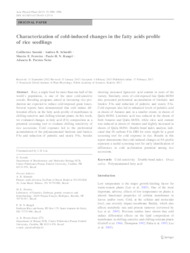Characterization of cold-induced changes in the fatty acids profile of rice seedlings.
Characterization of cold-induced changes in the fatty acids profile of rice seedlings.
Author(s): SASSAKI, G.; SCHMIDT, A. B.; FERREIRA, M. E.; RANGEL, P. H. N.; PEREIRA-NETTO, A. B.
Summary: Rice, a staple food for more than one half of the world?s population, is one of the most cold-sensitive cereals. Breeding programs aimed at increasing rice production are expected to reduce cold-imposed grain losses. Several reports have demonstrated that cold induce differential effects on the fatty acids profile of membranes in chilling-sensitive and chilling-tolerant plants. In this work, we evaluated changes in fatty acid (FA) composition as a potential screening tool to evaluate chilling sensitivity of rice accessions. Cold exposure led to the preferential accumulation of the polyunsaturated linolenic and linoleic FAs and reduction of palmitic and stearic FAs, besides showing increased lignoceric acid content in roots of the variety. Similarly, roots of cold-exposed line Quila 66304 also presented preferential accumulation of linolenic and linoleic FAs and reduction of palmitic and stearic FAs. Cold exposure also led to enhanced levels of palmitic acid in shoots of Amaroo and, in a smaller extent, in shoots of Quila 66304. Linolenic acid was reduced in the shoots of both Amaroo and Quila 66304, while oleic acid content was reduced in shoots of Amaroo and slightly increased in shoots of Quila 66304. Double-bond index analysis indicated that 18 carbons FAs DBI for roots might be a good screening tool for cold response in rice. Results in this report demonstrate that cold-induced changes in FA profile represent a useful screening tool for early identification of differences in cold acclimation potential among rice accessions.
Publication year: 2013
Types of publication: Journal article
Keywords: Arroz, Cold, Frio, Oryza sativa, Polyunsaturated fatty acids, Rice, Temperatura, Ácido graxo
Observation
Some of Embrapa's publications are published as ePub files. To read them, use or download one of the following free software options to your computer or mobile device. Android: Google Play Books; IOS: iBooks; Windows and Linux: Calibre.
Access other publications
Access the Agricultural Research Database (BDPA) to consult Embrapa's full library collection and records.
Visit Embrapa Bookstore to purchase books and other publications sold by Embrapa.

